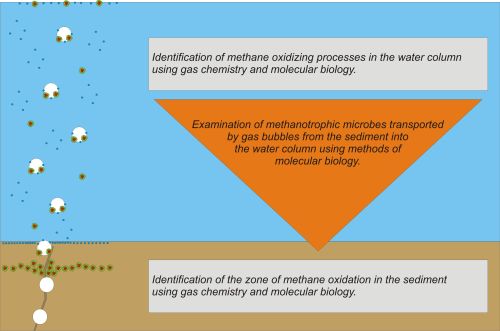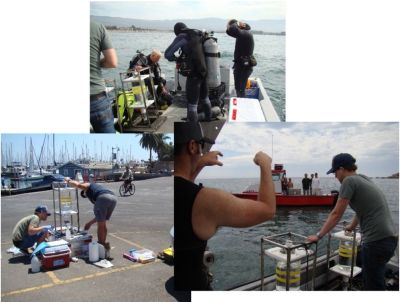
Preliminary Results
Bubble Shuttle II – Bentho-pelagic transport of methanotrophic microorganisms via gas bubbles, DFG SCHM 2530/7-1

The importance of methanotrophic microorganisms in the sediment and water column for balancing marine methane budgets is well accepted. However, whether methanotrophic populations are distinct for benthic and pelagic environments or are the result of exchange processes between the two, remains an area of active research. We conducted a field pilot study at the Rostocker Seep site (Coal Oil Point seep field, offshore California, USA) to test the hypothesis that bubble-mediated transport of methane-oxidizing microorganisms from the sediment into the water column is quantifiable. Measurements included dissolved methane concentration and showed a strong influence of methane seepage on the water-column methane distribution with strongly elevated sea surface concentrations with respect to atmospheric equilibrium (saturation ratio ~17,000%).
Using Catalyzed Reporter Deposition Fluorescence In Situ Hybridization (CARD FISH) analysis, aerobic methane oxidizing bacteria (MOB) were detected in the sediment and the water column, whereas anaerobic methanotrophs (ANME-2) were detected exclusively in the sediment. Critical data for testing the hypothesis were collected using a novel bubble catcher that trapped naturally emanating seep gas bubbles and any attached particles approximately 15 cm above the seafloor. Bubble catcher experiments were carried out directly above a natural bubble seep vent and at a nearby reference site, for which an “engineered” nitrogen bubble vent without sediment contact was created. Our experiments indicate the existence of a "Bubble Transport Mechanism", which transports MOB from the sediment into the water column. In contrast, ANME-2 were not detected in the bubble catcher. The Bubble Transport Mechanism could have important implications for the connectivity between benthic and pelagic methanotrophic communities at methane seep sites. Sebastian Jordan is the PhD student working in this project at the IOW and more information about the project can be found on his web side.

Field work at the Coal Oil Point seep field in Santa Barbara (CA). Top: preparation for diving at the seep site. Left: meeting of the two research vessels at the Rostocker Seep site. Right: subsampling of bubble catcher at Santa Barbara harbor.
Our field work will be carried out at the Coal Oil Point seep site (Santa Barbara, CA) and the abandoned well Blowout site 22/4b (North Sea). The microbiological investigations are coordinated by Prof. Dr. Heide Schulz-Vogt (IOW) and Prof. Dr. Tina Treude (UCLA), the sediment studies are supported by Dr. Olaf Dellwig (IOW), the oceanographic studies by Dr. Ulf Gräwe (IOW) and the gas chemistry is coordinated by Dr. Oliver Schmale (IOW). Sebastian Jordan is the PhD student working in this project at the IOW.
Related publications:
Schmale O., Leifer I., Schneider v. Deimling J., Stolle C., Krause S., Kießlich K., Frahm A., and Treude T. (2015). Bubble Transport Mechanism: Indications for a gas bubble-mediated inoculation of benthic methanotrophs into the water column, Cont. Shelf Res., 103, 70-78.
More media: